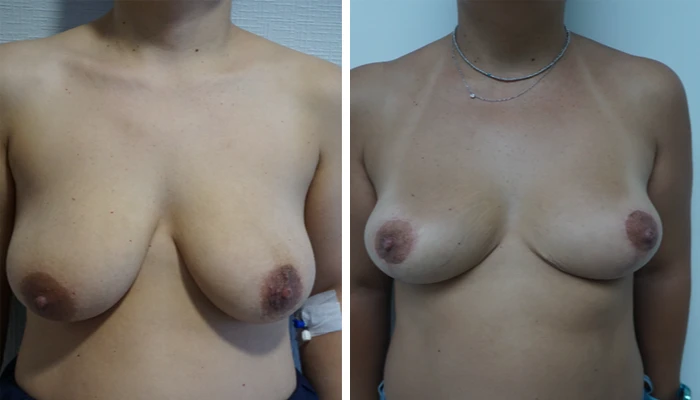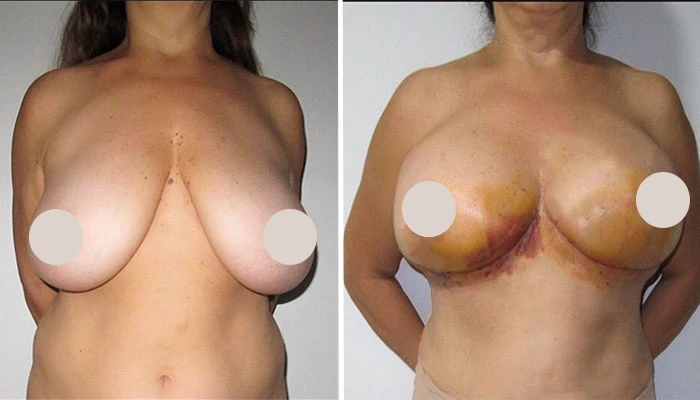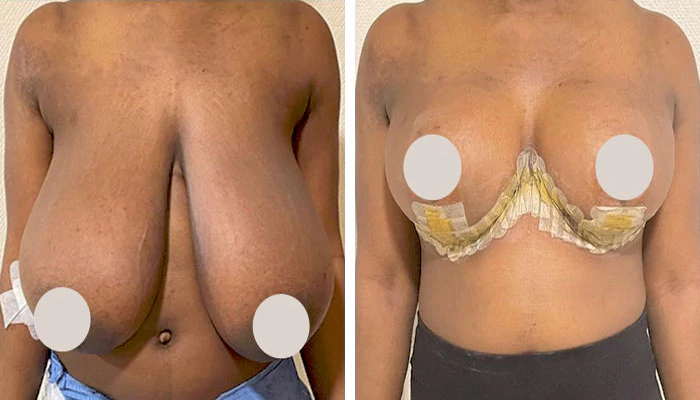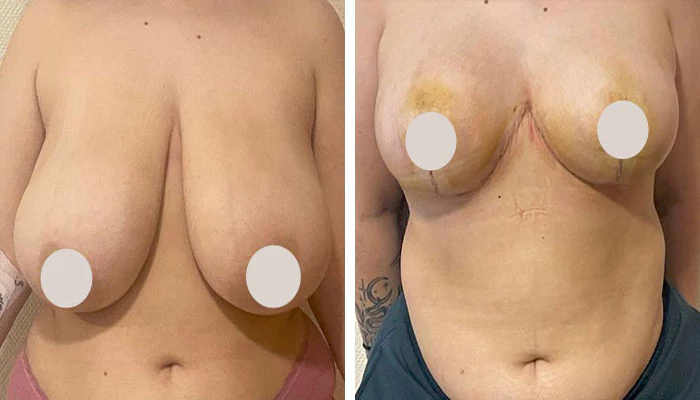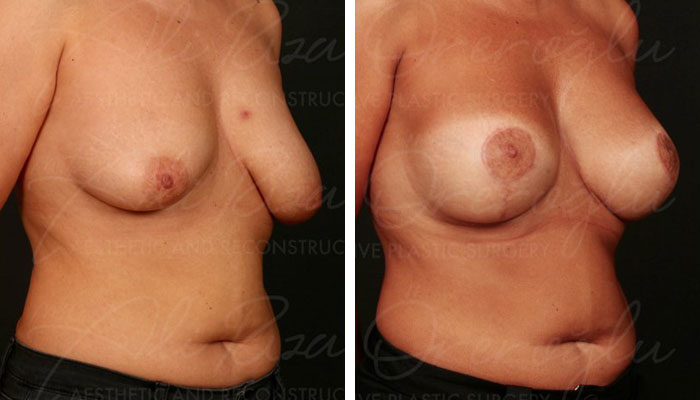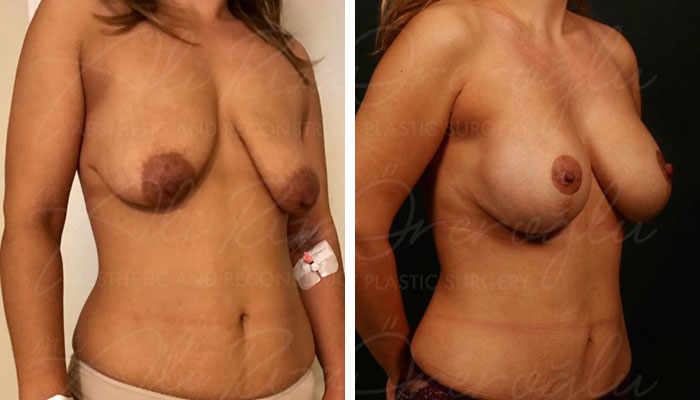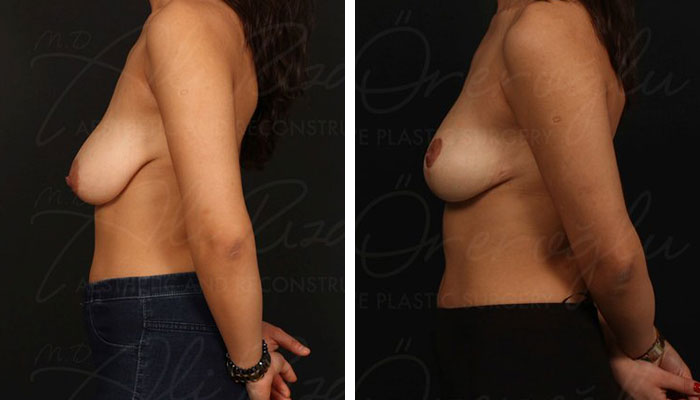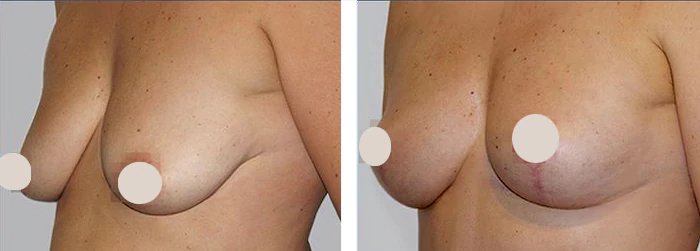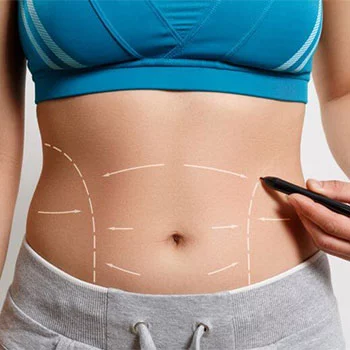What is a breast lift?
A breast lift, also known as mastopexy, is a cosmetic surgical procedure performed to raise and reshape sagging breasts. During a breast lift, excess skin is removed, and the surrounding tissue is tightened to support the new breast contour. This procedure can help improve the shape and firmness of the breasts, creating a more youthful and lifted appearance.
Breast lifts are commonly sought after by women who have experienced changes in their breast shape due to factors such as pregnancy, breastfeeding, weight fluctuations, or aging. It can be combined with other breast procedures like breast augmentation and reduction for optimal results.
What is the purpose of a breast lift?
A breast lift is performed to address sagging or drooping breasts, also known as breast ptosis. The primary purposes of a mastopexy procedure are:
- Breast firmness: A breast lift helps to restore firmness to breasts that have lost their shape and elasticity due to factors such as pregnancy, breastfeeding, weight fluctuations, or aging.
- Breast position: By lifting the breasts to a higher position on the chest, a breast lift can create a more youthful and rejuvenated breast profile.
- Nipple repositioning: The procedure can also reposition and resize the nipples and areolas to be more proportionate to the newly lifted breasts.
- Improved breast symmetry: A mastopexy can help improve breast symmetry by addressing differences in breast size, shape, or position.
Overall, the goal of a breast lift is to enhance the appearance of the breasts by giving them a firmer, more lifted, and aesthetically pleasing shape. It is important to have realistic expectations about the outcome of the procedure and to consult with a qualified plastic surgeon to determine the best approach for achieving your desired results.
Who are good candidates for a breast lift?
Good candidates for a mastopexy are typically individuals who are experiencing sagging or drooping breasts and are looking to improve the firmness and position of their breasts. Ideal candidates for a breast lift may exhibit the following characteristics:
- Sagging breasts: Candidates should have breasts that are sagging or have lost their shape and firmness due to factors such as pregnancy, breastfeeding, weight fluctuations, or aging.
- Healthy individuals: Candidates should be in good overall health and not have any medical conditions that could impair healing or increase the risks of surgery.
- Non-smokers: Smoking can negatively impact the healing process, so candidates are encouraged to quit smoking before undergoing a breast lift.
- Realistic expectations: Candidates should have realistic expectations about the outcome of the procedure and understand that a breast lift can improve breast sagging but may not significantly increase breast size.
- Stable weight: Candidates should be at a stable weight as fluctuations in weight can affect the results of the procedure.
- Finished childbearing: While it is possible to undergo a mastopexy before having children, it is generally recommended to wait until after completing childbearing to maintain the results of the surgery.
It is essential to consult with a board-certified plastic surgeon to determine if you are a suitable candidate for a breast lift based on your individual anatomy, goals, and medical history.
Tests to measure if your breasts are sagging
While a formal diagnosis of breast sagging, or breast ptosis, typically requires a professional evaluation by a healthcare provider, there are some simple self-assessment tests you can perform at home to get a general idea of the degree of breast sagging. These tests can help you become more aware of changes in your breast appearance over time. Here are a few self-assessment tests you can do at home:
Pencil test
- Stand in front of a mirror without a bra on.
- Place a pencil or pen under your breast where it meets the chest wall.
- If the pencil stays in place without any support, it may indicate some degree of breast sagging.
Nipple position test
- Stand in front of a mirror with your arms relaxed at your sides.
- Assess the position of your nipples in relation to the inframammary fold (crease beneath the breast).
- If your nipples point downward and fall below the fold, it may suggest breast sagging.
The hands-on test
- Place your hands on your hips with your elbows pointing out.
- Use your hands to lift your breasts to a higher position on your chest.
- Observe how your breasts look and feel when lifted. If they appear more perky and youthful, it may indicate some degree of breast ptosis.
It is important to note that these self-assessment tests are not definitive diagnostic tools and should not replace a professional evaluation by a healthcare provider. If you have concerns about breast sagging or changes in your breast appearance, it is recommended to schedule a consultation with a board-certified plastic surgeon or healthcare provider for a thorough assessment and personalized recommendations for treatment.
How to prepare for a mastopexy
Preparing for a breast lift surgery involves several steps to ensure a successful outcome and smooth recovery. Here are some general guidelines on how to prepare for the surgery:
- Consultation: Schedule a consultation with a board-certified plastic surgeon to discuss your goals, medical history, and expectations for the surgery. Your surgeon will evaluate your breast anatomy and overall health to determine if you are a suitable candidate for a breast lift.
- Medical evaluation: Your surgeon may require you to undergo a medical evaluation to assess your overall health and ensure you are physically fit for surgery.
- Quit smoking: If you are a smoker, it is recommended to quit smoking several weeks before the surgery to reduce the risk of complications and promote better healing.
- Medication review: Inform your surgeon about any medications, supplements, or herbal remedies you are taking, as some may need to be adjusted or temporarily stopped before the surgery.
- Avoid blood thinners: Avoid taking blood-thinning medications, such as aspirin, ibuprofen, or certain supplements, as they can increase the risk of bleeding during surgery. Your surgeon will provide specific instructions on which medications to avoid.
- Arrange for help: Plan for someone to drive you to and from the surgery and stay with you during the initial phase of recovery to assist with daily activities.
- Follow preoperative instructions: Your surgeon will provide you with specific preoperative instructions, which may include guidelines on eating and drinking before surgery, as well as restrictions on certain activities.
- Prepare your recovery space: Set up a comfortable recovery area at home with necessary supplies, such as loose, comfortable clothing, pillows for support, and medications prescribed by your surgeon.
By following these preparation steps and closely following your surgeon's instructions, you can help ensure a successful breast lift surgery and a smooth recovery process.
What to expect during a mastopexy?
During a breast lift surgery, several key steps are typically involved in the procedure. Here is an overview of what to expect during a mastopexy surgery:
- Anesthesia: The surgery is usually performed under general anesthesia, ensuring that you are asleep and pain-free during the procedure.
- Incision placement: Your surgeon will make incisions on the breasts following a predetermined pattern, which may include around the areola, vertically down to the breast crease, and horizontally along the breast crease (anchor-shaped incision).
- Reshaping the breast tissue: Excess skin is removed, and the underlying breast tissue is reshaped and lifted to create a more youthful and firmer breast contour.
- Nipple repositioning: If necessary, the nipples and areolas may be repositioned to a higher placement on the breasts for a more proportionate look.
- Closing incisions: After reshaping the breast tissue and repositioning the nipples, the incisions are carefully closed with sutures, skin adhesives, or surgical tape.
- Drain placement (optional): In some cases, drainage tubes may be placed to prevent fluid buildup and aid in the healing process. Your surgeon will provide instructions on drain care if needed.
- Bandaging: The breasts are typically wrapped in a surgical bra or bandages to provide support and protect the incisions during the initial stages of healing.
- Recovery: You will be monitored in a recovery area as the effects of anesthesia wear off. Your surgeon or medical team will provide postoperative care instructions and information on what to expect during the recovery period.
It is important to follow your surgeon's postoperative care instructions closely to promote proper healing and achieve optimal results. Swelling, bruising, and discomfort are common after surgery, but these symptoms can be managed with pain medication and by following recommended guidelines for recovery. Your surgeon will schedule follow-up appointments to monitor your progress and ensure that you are healing properly.
Different types of breast lift techniques
There are several types of breast lift techniques, including:
- Crescent lift: Involves a small crescent-shaped incision around the top half of the areola for minimal lift.
- Peri-areolar or donut lift: Uses a circular incision around the areola for moderate lift.
- Vertical or lollipop lift: Combines a circular incision around the areola with a vertical incision down to the breast crease for moderate to significant lift.
- Anchor or wise pattern lift: Involves an inverted T-shaped incision, including a horizontal incision along the breast crease, for significant lift and reshaping.
The choice of technique depends on factors like the degree of ptosis (sagging), breast size, and desired outcome, which can be discussed with a plastic surgeon during a consultation.
Recovery and aftercare
Recovery and aftercare following a mastopexy are crucial for achieving optimal results and minimizing complications. Here are some general guidelines for recovery and aftercare following a breast lift:
- Initial recovery period: The initial recovery period typically involves wearing a surgical bra or compression garment to provide support and minimize swelling. Your surgeon may recommend limiting physical activities and avoiding strenuous exercise for several weeks.
- Pain management: Your surgeon may prescribe pain medication to help manage any discomfort during the initial stages of recovery. It is important to take the medication as directed and avoid taking any medications that can thin the blood and increase the risk of bleeding.
- Follow-up appointments: Attend all scheduled follow-up appointments with your surgeon to monitor your healing progress and address any concerns or questions you may have.
- Incision care: Follow your surgeon's instructions on how to care for your incisions, including keeping them clean and dry, applying any recommended ointments or dressings, and watching for signs of infection.
- Avoiding certain activities: Avoid lifting heavy objects, reaching or stretching overhead, and engaging in strenuous activities that could strain the surgical area.
- Diet and hydration: Maintain a healthy diet and stay hydrated to support the healing process and promote optimal recovery.
- Scar care: Follow your surgeon's recommendations for scar care, which may include massage, silicone sheets, or scar creams to help minimize the appearance of scars over time.
- Physical therapy: Your surgeon may recommend gentle breast massage or exercises to promote healing and maintain breast shape and flexibility.
- Long-term care: Attend regular check-ups with your surgeon to monitor the long-term results of your breast lift and address any changes or concerns that may arise.
It is essential to follow your surgeon's postoperative care instructions closely and reach out to your medical team if you have any questions or experience any unexpected symptoms during your recovery. By taking care of yourself and following recommended guidelines, you can help ensure a smooth recovery and achieve the best possible outcome from your breast lift surgery.
Risks and complications of breast lift
Like any surgical procedure, a mastopexy carries certain risks and potential complications. It is important to be aware of these risks before undergoing surgery. Some of the risks and complications associated with a breast lift may include:
- Infection: There is a risk of developing an infection at the incision sites, which may require antibiotics or additional treatment.
- Changes in sensation: Temporary or permanent changes in nipple or breast sensation, including numbness or hypersensitivity, may occur after surgery.
- Scarring: While efforts are made to minimize scarring, visible scars are inevitable after a breast lift. Scars may fade over time but may remain noticeable.
- Delayed wound healing: Some individuals may experience delayed wound healing, which can lead to wound separation or other complications.
- Changes in breast shape: In some cases, changes in breast shape or symmetry may occur after a breast lift, requiring additional procedures for correction.
- Fluid accumulation (seroma): Fluid buildup under the skin (seroma) may occur after surgery and may need to be drained by a healthcare provider.
- Blood clots: There is a risk of developing blood clots (deep vein thrombosis) after surgery, especially if you have certain risk factors.
- Anesthesia risks: General anesthesia carries its own set of risks, including allergic reactions, breathing difficulties, or adverse reactions to anesthesia medications.
- Unsatisfactory results: While a breast lift can improve breast sagging, there is a possibility that the results may not meet your expectations or aesthetic goals.
It is essential to discuss these risks and complications with your plastic surgeon during the consultation process and follow all preoperative and postoperative instructions to minimize the likelihood of complications. Be sure to choose a board-certified plastic surgeon with extensive experience in breast lift procedures to help reduce the risks associated with surgery.
How much does a breast lift cost?
The cost of a breast lift or mastopexy can vary depending on several factors, including the geographic location of the surgical facility, the experience and reputation of the plastic surgeon, the complexity of the procedure, the type of facility where the surgery is performed, and any additional fees associated with anesthesia, postoperative care, and follow-up appointments. In the United States, the average cost of a breast lift surgery can range from $5,000 to $10,000 or more.
It is essential to consider that the cost of a breast lift may not only include the surgical fees but also other expenses such as preoperative consultations, postoperative garments, prescription medications, and follow-up appointments. Some facilities may offer financing options to help patients manage the cost of surgery.
During your initial consultation with a board-certified plastic surgeon, you will receive a personalized quote that outlines the total cost of the procedure based on your specific needs and goals. It is important to choose a qualified and experienced plastic surgeon who can provide safe and effective results, even if their fees may be higher. Additionally, be sure to inquire about what is included in the total cost and if there are any potential additional fees to consider.
Breast lift, breast augmentation, and breast reduction: which is right for me?
Breast lift, breast augmentation, and breast reduction are different procedures aimed at improving the appearance of the breasts. Determining whether a breast lift, breast augmentation, or breast reduction is right for you depends on your individual goals, concerns, and anatomical characteristics. Here is a brief overview of each procedure to help you understand the differences and decide which option may be suitable for you:
- Breast lift
- Purpose: A breast lift is performed to lift and reshape sagging breasts, improve breast firmness, and reposition the nipples for a more youthful appearance.
- Ideal candidates: Individuals with sagging breasts due to factors such as pregnancy, breastfeeding, weight fluctuations, or aging, who want to address breast ptosis without significantly changing breast size.
- Results: A breast lift can improve breast shape and position but does not significantly alter breast size or volume.
- Breast augmentation
- Purpose: Breast augmentation is performed to increase breast size, enhance breast shape, improve symmetry, or restore volume lost due to weight loss or aging.
- Ideal candidates: Individuals who desire larger breasts, more volume, improved breast shape, or enhanced cleavage.
- Results: Breast augmentation uses implants or the patient’s own fat (fat grafting) to increase breast size and enhance overall breast appearance.
- Breast reduction
- Purpose: Breast reduction is performed to reduce breast size, alleviate physical discomfort (such as back pain or neck pain), improve body proportions, and enhance overall breast shape.
- Ideal candidates: Individuals with disproportionately large breasts that cause discomfort, pain, or self-esteem issues.
- Results: Breast reduction surgery removes excess breast tissue to achieve a smaller, more proportionate breast size.
To determine which procedure is right for you, it is crucial to consult with a board-certified plastic surgeon who can assess your individual concerns, goals, and anatomical characteristics.
In some cases, a breast lift can be combined with a breast augmentation or breast reduction to achieve the desired results. This combination procedure, known as augmentation mastopexy (for a breast lift with augmentation) or reduction mastopexy (for a breast lift with reduction), allows patients to address multiple concerns in a single surgery.
- Augmentation mastopexy: This combination procedure is suitable for individuals who wish to not only lift sagging breasts but also increase breast size and improve overall breast shape and fullness. By combining a breast lift with breast augmentation using implants or fat transfer, patients can achieve a more youthful and fuller breast appearance.
- Reduction mastopexy: For individuals with large, sagging breasts who also desire a reduction in breast size, a reduction mastopexy can be performed. This procedure involves lifting the breasts to a higher position on the chest while simultaneously reducing excess breast tissue to achieve a more proportionate and lifted breast contour.
Combining a breast lift with augmentation or reduction can offer comprehensive improvements in breast size, shape, and position, resulting in enhanced overall breast aesthetics. However, the decision to undergo a combined procedure should be carefully discussed with your plastic surgeon to ensure that it aligns with your goals, anatomy, and expectations. Your surgeon will assess your unique needs and recommend the most appropriate approach to help you achieve your desired outcome.
FAQs
How long does a breast lift surgery take?
A breast lift surgery typically takes around 2 to 4 hours, depending on the complexity of the procedure and individual factors.
Will a breast lift leave visible scars?
A breast lift may leave visible scars, but a skilled surgeon aims to minimize scarring and make incisions in discreet locations.
Will nipples look normal after a breast lift?
After a breast lift, nipples typically retain a normal appearance. A skilled surgeon takes care to maintain proper nipple position and shape during the procedure to achieve natural-looking results.
How long should I wear a surgical bra after a breast lift?
It is generally recommended to wear a surgical bra after a breast lift for several weeks to promote healing, provide support, and help maintain the results of the surgery. Your surgeon will provide specific instructions based on your individual recovery process and may advise you on when it is appropriate to transition to a regular bra.
How long will the results last?
The results of a breast lift are long-lasting, but factors like aging and lifestyle choices can affect the longevity of the outcome. Maintenance may involve proper skincare and regular check-ups.

